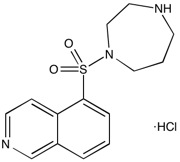Fasudil HCl | ROCK inhibitor
NMR (Conforms)

Available Options
| Size : | Price | Quantity | |
|---|---|---|---|
| 50 mg | $52.00 | ||
| 250 mg | $155.00 |
Fasudil HCl (105628-07-7) is a Rho-associated kinase inhibitor (IC50 = 1.9 μM and 10.7 μM for Rho-associated kinase II and Rho-associated kinase respectively)1. Inhibits other kinases including cyclic nucleotide-dependent protein kinases.1 Fasudil HCl reduces tryptamine-evoked vasopressor responses.2 Attenuates bleomycin-induced pulmonary fibrosis in a mouse model.3 Clinically useful vasodilator.
References/Citations:
1) Davies et al. (2000), Specificity and mechanism of action of some commonly used protein kinase inhibitors; Biochem. J., 351 95
2) Anwar et al. (2013), Signal transduction and modulating pathways in tryptamine-evoked vasopressor responses of the rat isolated perfused mesenteric bed; Vascul. Pharmacol., 58 140
3) Jiang et al. (2012), Fasudil, a rho-kinase inhibitor, attenuates bleomycin-induced pulmonary fibrosis in mice; Int. J. Mol. Sci., 13 8293
NMR (Conforms)
Safety Data Sheet:
Product Data Sheet:
Materials provided by Focus Biomolecules are for laboratory research use only and are not intended for human or veterinary applications. Please note that we do not sell to individuals and that all orders placed by non-research organizations will incur a $20 restocking/refund fee
Fasudil HCl (105628-07-7) is a Rho-associated kinase inhibitor (IC50 = 1.9 μM and 10.7 μM for Rho-associated kinase II and Rho-associated kinase respectively)1. Inhibits other kinases including cyclic nucleotide-dependent protein kinases.1 Fasudil HCl reduces tryptamine-evoked vasopressor responses.2 Attenuates bleomycin-induced pulmonary fibrosis in a mouse model.3 Clinically useful vasodilator.
References/Citations:
1) Davies et al. (2000), Specificity and mechanism of action of some commonly used protein kinase inhibitors; Biochem. J., 351 95
2) Anwar et al. (2013), Signal transduction and modulating pathways in tryptamine-evoked vasopressor responses of the rat isolated perfused mesenteric bed; Vascul. Pharmacol., 58 140
3) Jiang et al. (2012), Fasudil, a rho-kinase inhibitor, attenuates bleomycin-induced pulmonary fibrosis in mice; Int. J. Mol. Sci., 13 8293
Related Stem Cell Survival Products
Download
Calculate the molar concentration, mass or volume in a solution.
Concentration × Volume × Molecular Weight = Mass
Focus Biomolecules • Plymouth Meeting, PA USA • 1-855-FOCUS21
Focus Biomolecules
Plymouth Meeting, PA USA
1-855-FOCUS21
Website Created by Advanta Advertising LLC.

